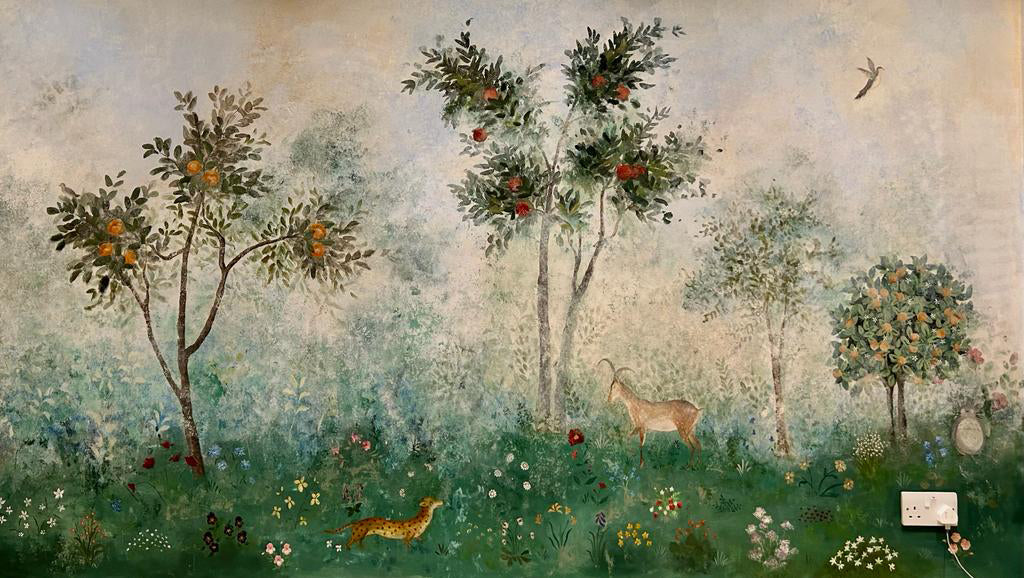
Introduction
Murals have transcended their traditional confines, emerging as a dominant force in contemporary interior design. Once reserved for public spaces and street art, murals are now coveted wall coverings in homes and businesses alike. This article delves into the significance of this trend, highlights leading artists and their notable works, compares murals to traditional wall coverings, and explores the factors contributing to their rising popularity and future prospects.
The Evolution of Murals in Interior Design
Historically, murals have been integral to human expression, from the cave paintings of Lascaux to the frescoes of the Renaissance. In modern times, murals have evolved, influenced by technological advancements and cultural shifts.
Technological Advancements: The advent of digital printing has revolutionized mural creation, allowing for high-resolution, customizable designs that can be tailored to individual preferences. This technology enables intricate details and vibrant colors, making murals more accessible and appealing for interior applications.
Influence of Street Art: The rise of street art has brought murals into the limelight, with artists like Banksy and Shepard Fairey gaining international acclaim. Their work has blurred the lines between public art and interior design, inspiring homeowners to incorporate mural aesthetics into their living spaces.
Top Artists Leading the Mural Revolution
Several contemporary artists have significantly influenced the integration of murals into interior design:
Guido van Helten: An Australian artist renowned for his photorealistic murals, van Helten’s work often portrays human subjects with profound emotional depth. His murals have adorned both public spaces and private interiors, adding a touch of humanity and storytelling to walls.
Shepard Fairey: Known for his iconic “Obey” series and the Barack Obama “Hope” poster, Fairey’s work combines political messages with striking visuals. His designs have been adapted into mural wallpapers, bringing a bold statement to interior spaces.
Swoon (Caledonia Curry): As a pioneering female street artist, Swoon’s intricate paper-cut portraits have transitioned from urban walls to interior designs, offering a blend of delicacy and urban edge.
Notable Murals as Wall Coverings and Their Price Points
The demand for murals in interior design has led to notable sales and installations:
Julianna Byrne’s Botanical Murals: Byrne’s hand-painted botanical murals have been featured in high-end interiors, with custom commissions starting at $10,000, depending on the complexity and size of the project.
Tess Newall’s Decorative Murals: Known for her playful and dynamic designs, Newall’s murals have transformed both residential and commercial spaces. Custom mural projects by Newall can range from $15,000 to $50,000, reflecting the bespoke nature of her work.
Sam Wood’s Colorful Transformations: Wood’s vibrant murals have been installed in locations such as Rixo’s store and a Notting Hill townhouse, showcasing the transformative power of murals in interior design. Commissioned murals by Wood typically start at $20,000, with prices varying based on design intricacy and scale.
Comparing Murals to Traditional Wall Coverings
When considering wall coverings, murals offer distinct advantages over traditional options like wallpaper and paint:
Uniqueness: Murals provide a one-of-a-kind design tailored to the space, whereas wallpaper patterns are mass-produced.
Artistic Expression: Murals serve as large-scale artworks, adding depth and narrative to a room, unlike the repetitive patterns of traditional wallpapers.
Customization: Murals can be customized to reflect personal tastes, themes, or the room’s purpose, offering flexibility that traditional wall coverings may lack.
The Popularity Surge: Why Murals Are Taking Over
Several factors contribute to the growing popularity of murals in interior design:
Personalization: Homeowners seek unique, personalized spaces that reflect their identity, and murals offer a bespoke solution.
Aesthetic Appeal: Murals can dramatically transform a space, adding visual interest and character that traditional wall coverings may not achieve.
Cultural Influence: The integration of art into daily living spaces reflects a broader cultural appreciation for creativity and individuality.
The Future of Murals in Interior Design
The trajectory of murals in interior design suggests continued growth and innovation:
Integration with Technology: Advancements in augmented reality (AR) and virtual reality (VR) could lead to interactive murals that change based on viewer interaction or time of day.
Sustainability: Eco-friendly materials and sustainable practices in mural creation will appeal to environmentally conscious consumers.
Market Growth: As demand increases, the market for murals is expected to expand, potentially leading to higher prices for commissioned works and limited-edition mural wallpapers.
Conclusion
Murals have emerged as a transformative trend in interior design, offering unique, customizable, and artistically rich wall coverings that stand apart from traditional options. With contributions from leading artists and a growing appreciation for personalized spaces, murals are set to redefine interior aesthetics, making walls not just boundaries but canvases of expression.
The artwork highlighted and used in this piece is by Tess Newall entitled Mythical Playroom
For Inquiries and Exclusive Promotions:
Explore our curated offerings at Artists Breath.
Discover Our Exquisite Collection:
Immerse yourself in our distinguished selection of fine art at Artists Breath Collection.
Connect with Our Artists and Gallery:
For personalized assistance or to engage with our talented artists, please reach out at info@artistsbreath.com.
Stay Informed with Our Insights:
Subscribe to our Substack for the latest in art and culture at Artists Breath Substack.